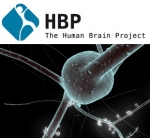
Human Brain Project (HBP) at KTH CSC CB
 On January 28 2013 the Human Brain Project (HBP) together with the Graphene
project won the European Commission's Future Emerging Technologies Flagship
Award. The total funding for each project amounts to 1 billion Euro over 10 years.
About half of this is from EU and this is the largest research grant ever awarded.
On January 28 2013 the Human Brain Project (HBP) together with the Graphene
project won the European Commission's Future Emerging Technologies Flagship
Award. The total funding for each project amounts to 1 billion Euro over 10 years.
About half of this is from EU and this is the largest research grant ever awarded.
Researchers at the school of Computer Science and Communication at KTH are
involved in different aspects of HBP:
- Prof. Jeanette Hellgren Kotaleski -
workpackage leader in the Simulation division
- Prof. Anders Lansner - task leader
in the Neuromorphic computing division
- Prof. Erwin Laure - director of
PDC and HPCViz at KTH, the Neuromorphic computing division
 The project is planned to start in September
2013 and will formally be an integrated project in FP7 during the startup phase of
2 ½ years. Conditional on a successful evaluation of the startup phase the full
project will be launched and run for another 7 ½ years within the next EU
framework program Horizon 2020.
The project is planned to start in September
2013 and will formally be an integrated project in FP7 during the startup phase of
2 ½ years. Conditional on a successful evaluation of the startup phase the full
project will be launched and run for another 7 ½ years within the next EU
framework program Horizon 2020.
HBP is above all funding the strategically important interface between
experimental brain science and information science and technology,
encompassing fields like computational neuroscience and brain simulation,
cognitive neuroscience, neuroinformatics (brain databases, data analysis and
visualization applied to data from the brain), neurorobotics, medical informatics,
and neuromorphic computing.
The goal of the Human Brain Project is to pull together all our existing knowledge
about the human brain and to reconstruct the brain, piece by piece, in
supercomputer-based models and simulations. The models offer the prospect of
a new understanding of the human brain and its diseases and of completely new
computing and robotic technologies.
For more information on HBP, see
http://www.humanbrainproject.eu/
Researchers at KTH will be involved mainly in the computational neuroscience,
brain simulation and neuromorphic computing aspects of HPB.
The computational neuroscience and brain simulation research aims to develop
tools for multi-scale supercomputer brain simulation and to use those to build
and investigate mathematical models of brain structures and processes, from the
molecular to the large-scale neuronal network levels. Together with the existing
and new knowledge from experimental research this will help to understand brain
processes and functions in terms of the underlying synaptic and neuronal
mechanisms, relating to the healthy as well as the diseased and dysfunctional
brain. The increased knowledge will be crucial for development of new and better
tools for diagnosis and treatment of brain diseases and disorders.
The neuromorphic computing research aims to utilize the increased knowledge
about basic information processing principles behind brain functions to build
brain-like technology for advanced applications. At the present early and
explorative stage of this research simplified versions of the multi-scale simulation
models mentioned above are used to solve challenging machine learning, pattern
recognition and inference problems. These computational models are further
implemented in dedicated neuromorphic hardware - so called 'neurochips' - to
make the computations fast, compact, low-power, and cheap.
March 2013
Stockholm
 On January 28 2013 the Human Brain Project (HBP) together with the Graphene
project won the European Commission's Future Emerging Technologies Flagship
Award. The total funding for each project amounts to 1 billion Euro over 10 years.
About half of this is from EU and this is the largest research grant ever awarded.
On January 28 2013 the Human Brain Project (HBP) together with the Graphene
project won the European Commission's Future Emerging Technologies Flagship
Award. The total funding for each project amounts to 1 billion Euro over 10 years.
About half of this is from EU and this is the largest research grant ever awarded.

 The project is planned to start in September
2013 and will formally be an integrated project in FP7 during the startup phase of
2 ½ years. Conditional on a successful evaluation of the startup phase the full
project will be launched and run for another 7 ½ years within the next EU
framework program Horizon 2020.
The project is planned to start in September
2013 and will formally be an integrated project in FP7 during the startup phase of
2 ½ years. Conditional on a successful evaluation of the startup phase the full
project will be launched and run for another 7 ½ years within the next EU
framework program Horizon 2020.